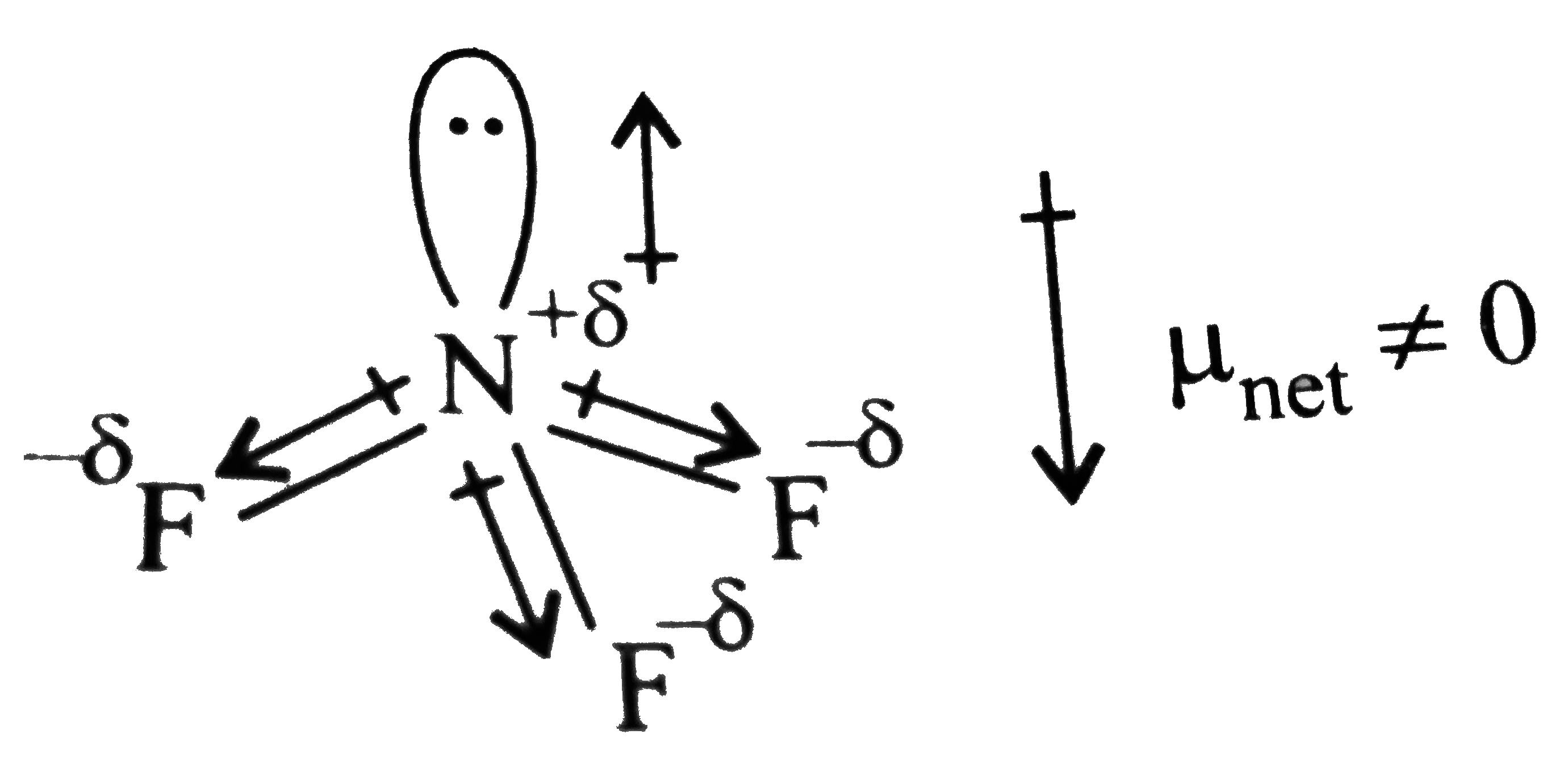Give reasons for the following
(a) is know but is not
(b) is a good solvent
(c ) is non- polar but planar
(e) Carbon -oxygen bond lengths are equal in
(f) is more soluble in water than .
Valence electronic configuration of N-atom does not have vacant d-orbitals, so it cannot form five bonds with (although of is very high) So is not know
(ii) Valence electronic configuration of P-atom have vacant 3d-orbitals and of is very high so F-atom can excite to 3d orbitals thus forming five bonds with is known
(b) is a good solvent because
(i) It is highly polar
(ii) It is capable of forming H-bonds among their molecules
(iii) For ionic solutes, it acts as a dielectric (substances which lower the strenght of eletric field)
(c) In B-atom is hybridised hence the shape of molecule is (triangular) planar But due symmertic structure
(d) N-atom in is hybridised and the strure is pyramidal due to the presence of one lp of N-atom which gives a net (dipole moment) to molecule i.e which results in a polar molecule
(e)
The ion shows resonance as follows Due to delocalisation of all bonds are of similar nature and hence they have equal bond lenghts
(f) is more ionic than (Fajans' rule) hence is more soluble in than
[Small cation, large anion more covalent less soluble in


 .
.
Topper's Solved these Questions
- CHEMICAL BONDING AND MOLECULAR STRUCTUREBOOK - CENGAGE CHEMISTRYCHAPTER - CHEMICAL BONDING AND MOLECULAR STRUCTUREEXERCISE - Ex 2 .2 Objective
34 Videos
- CHEMICAL BONDING AND MOLECULAR STRUCTUREBOOK - CENGAGE CHEMISTRYCHAPTER - CHEMICAL BONDING AND MOLECULAR STRUCTUREEXERCISE - Exercises Linked Comprehension
43 Videos
- CHEMICAL BONDING AND MOLECULAR STRUCTUREBOOK - CENGAGE CHEMISTRYCHAPTER - CHEMICAL BONDING AND MOLECULAR STRUCTUREEXERCISE - Ex 2 .2 Subjective (Intermolecular Forces And H-Bonding)
7 Videos
- ATOMIC STRUCTUREBOOK - CENGAGE CHEMISTRYCHAPTER - ATOMIC STRUCTUREEXERCISE - Concept Applicationexercise(4.3)
19 Videos
- CHEMICAL EQUILIBRIUMBOOK - CENGAGE CHEMISTRYCHAPTER - CHEMICAL EQUILIBRIUMEXERCISE - Archives (Subjective)
11 Videos
Similar Questions
Give reasons for the following
(a) CO2 has no dipole moment but SO2 and H2O have considerable dipole moments
(b) Carbon has two unpaired electrons in the outermost orbit, but it is tetravalent in organic compound
(c ) CaF2 is more ionic than CaI2
(d )Sigma bonds are stronger than pi bonds
(e) C2H4 is planar while C2H2 is linear
(f) H2O is more polar than H2S
(g) Ionic compounds do not canduct electricity in solid state, but they conduct electricity in solution or in molten state .
View SolutionAssertion :H0O2is non − ionic compound.
Reason : The O−O bond length in H2O2 is shorter than that of O2F2.
View Solution
Knowledge Check
Na2CO3.10H2O is
AWashing sodaBBaking sodaCBleaching powderDSlaked limeThe correct roder o fincreasing C−O bond lengths in CO,CO2−3 and CO2 is :
ACO2−3>CO2>COBCO2>CO2−3>COCCO>CO2−3>CO2DCO>CO2>CO2−3Given the correct order of initials T or F for following statements. Use T if statements is true and F it it is false:
(I)(CH3)2P(CF3)3 is non-palar and (CH3)3P(CF3)2 is polar molecule
(II)CH3ˆPCH3 bond angle are equal in (CH3)3P(CF3)2 molecule
(III) PF3 will be more soluble in polar solvent than SiF4ATTFBFFTCFFFDFTT
Bond angle in NH3 is more than in H2O. Discuss
View SolutionAll the C-O bonds in carbonate in (CO2−3) are equal in length. Explain.
View SolutionAll the C-O bonds in carbonate in (CO2−3) are equal in length. Explain.
View SolutionCH3COO− ion is more stable than C2H5O− ion. Assign reason.
View SolutionAssertion: CCl4and H2Oare immiscible .
Reason : CCl4 is a polar solvent.
View Solution
